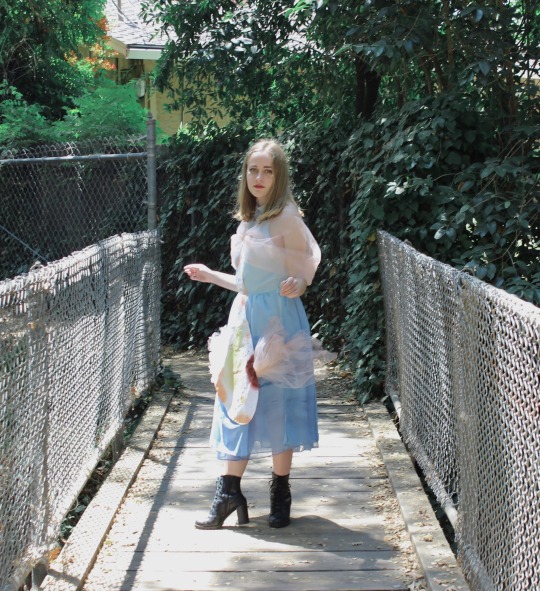#designed and sewn by me (Kay S.)
Text
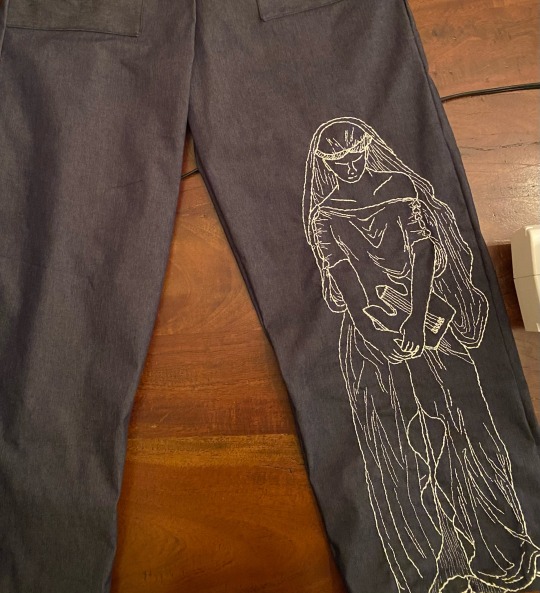


“Sapho on the rock of Lefada” embroidered on handmade jeans
#sewing#jeans#fashion#lesbian#wlw#Sappho#sapphic#lesbian fashion#fashion design#embroidery#hand embroidery#slow fashion#Modeled by Lily L#designed and sewn by me (Kay S.)#sapphiccloset
438 notes
·
View notes
Text
Cinderella September-through-November: "Cinderella" (2021 Sony/Amazon film)

At last we reach the most recent adaptation of Cinderella. This movie musical was produced by Sony Pictures and Amazon studios and released digitally on Amazon Prime Video, written and directed by Kay Cannon. The starry cast is headed by Cuban-American pop singer Camila Cabello in the title role, with Nicholas Galitzine as her Prince, Idina Menzel as her stepmother Vivian, Pierce Brosnan and Minnie Driver as the King and Queen, and Billy Porter as "Fab G," Ella's genderless, glamorously androgynous "Fabulous Godmother."
This film is a "jukebox musical," with a contemporary pop soundtrack despite its setting in a stylized 19th century, consisting mostly of preexisting songs: Janet Jackson's "Rhythm Nation," Des'ree's "You Gotta Be," Queen's "Somebody to Love" (a surprising choice, since it was already used in another cinematic Cinderella, 2004's Ella Enchanted – although there it was sung by Ella, while here the Prince sings it), Madonna's "Material Girl," Nico & Vinz's "Am I Wrong?", Earth, Wind and Fire's "Shining Star," Salt-N-Pepa's "Whatta Man," the White Stripes' "Seven Nation Army," Ed Sheeran's "Perfect," the Struts' "Could Have Been Me," and Jennifer Lopez's "Let's Get Loud." There are also two original songs, both written by their singers: "Dream Girl" by Idina Menzel, and the film's theme song, "Million to One" by Camila Cabello.
Cabello's Cinderella, real name Ella, is kind yet sassy, scruffy, slightly clumsy and endlessly determined: a first cousin to Emma Watson's blunt, quirky Belle in Disney's 2017 remake of Beauty and the Beast. And like Belle, she's scorned by her fellow villagers for having desires beyond housework and marriage: in this case, her dream is to start her own business as a fashion designer. When not serving Vivian and stepsisters Malvolia and Narissa, she sketches and sews dresses in her basement room. But the kingdom's patriarchy is stifling, not just for Ella, but for Vivian too (whose first husband left her because she sought a career outside the home), and for the royal family, as the overbearing King Rowan pressures Prince Robert to marry while sidelining his own wife Queen Beatrice and their political-minded daughter Princess Gwen.
When Ella makes a spectacle of herself at a public event and responds to the King's scolding with sass, Prince Robert is instantly smitten and disguises himself as a commoner to look for her in town. When he finds her, he buys one of her hand-sewn dresses for his sister, and then invites her to the ball: the perfect chance to find a patron for her business. Unfortunately, no sooner has Ella made herself a ballgown than Vivian throws ink on it to prevent her from going. But luckily, Ella has been caring for a caterpillar she rescued, and just in time it becomes a butterfly... which in turn transforms into Fab G., whose magic changes Ella's most fanciful dress design into a real ballgown for her.
At the ball, not only does Ella find love with Robert, but meets a foreign queen eager to employ her as a dressmaker on her travels around the world. But this comes at a cost, as when Robert proposes marriage, Ella realizes that becoming a princess would mean losing her career. Sadly but resolutely, she chooses her dreams over love. But the threat of losing both looms over her, as back at home, Vivian resolves to force her to marry the village greengrocer. But thanks to Ella's strong will, Robert's love, and the Queen finally calling out the King's selfish behavior, all eventually ends happily. Ella gains her career and Robert gives up his royal duties to travel with her, while his sister Gwen takes his place as heir to the throne.
This new twist on the tale is controversial and my feelings about it are very mixed. The feminist message is well-meaning but ham-fisted; the kingdom's "stay in the kitchen" attitude toward women is over-the-top even for a fairy tale. Why is there such backlash against Ella's goals when women have been fashion designers since at least the 1720s? Also in feminism's name, the stepfamily is made more sympathetic than usual, but as a result the film seems all too unsure if Vivian is an abuser or just a stern foster parent trying to tame Ella for her own good. Then there are Ella's three CGI mouse friends (voices of James Corden, James Acaster and Romesh Rangathan, who play the roles onscreen when they become a coachman and footmen), whose presence is more silly than funny, and the fact that despite everything it deconstructs, the film still plays Love at First Sight basically straight. This makes the proposal-rejection scene less sad than it would have been with a better developed romance.
Still, at heart this is just a perky, colorful musical that doesn't take itself too seriously, and despite its flaws it offers plenty to enjoy. The visuals have just the right fairy tale atmosphere, with Ellen Mirojnick, who also designed the costumes for the beloved 1997 Cinderella starring Brandy, creating a clothing aesthetic different than her earlier one but just as colorful and striking, with more of a blend of 19th century and modern styles. Cabello's Ella is a lively, likable heroine, while Galitzine, Porter, Menzel, Brosnan, Driver, Corden, and the rest of the cast all play their roles to the manner born (regardless of the writing's quality). The singing, rapping and dancing is all first-rate, and while the delivery might be heavy-handed, it is empowering for girls to see an ambitious, talented Cinderella who defies oppressive tradition and creates her own happy ending.
My feelings about this musical are similar to my feelings about 2004's Ella Enchanted. It will never be a definitive Cinderella, but many preteen and teenage viewers will doubtlessly love it, and as a whole, it's a spirited, lighthearted good time.
@superkingofpriderock, @ariel-seagull-wings
#cinderella#fairy tale#cinderella september through november#2021#sony pictures#amazon studios#amazon prime#live action film#musical#camila cabello
14 notes
·
View notes
Text
Music: Miniature Board

“Music” Miniature Board
Commissioned as part of a series on the same theme by Neale Albert, New York, USA.
Measuring 3 inches square
Made in 2020
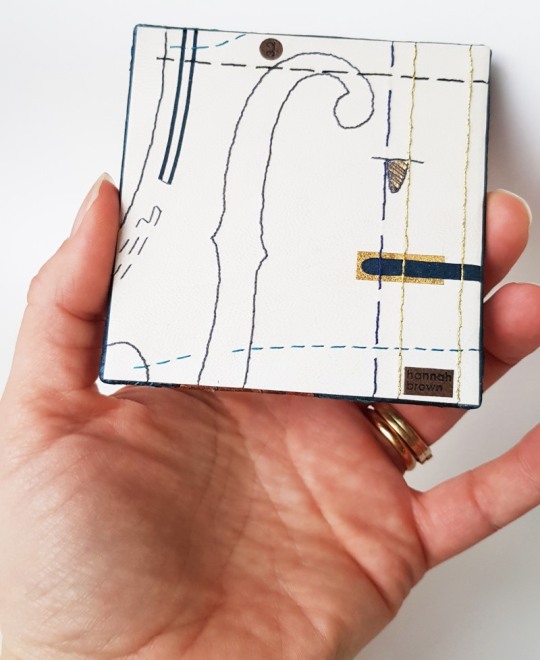
This series of boards was inspired by a collection of full size boards which Neale Albert was shown during a trip to George Bayntuns in Bath in 2018. The boards he saw had all been made by members of Designer Bookbinders for a separate project on the theme of Architecture. This project gave Neale the idea for a new project: a series of miniature designer bound boards on the theme of music, three inches (7.62 centimetres) square in size. In early 2019 myself and a number of other binders were asked to participate in this project. Each binder was given total control of the design of their piece (as usual for Neale's commissions) the only common ground between them was to be the size and the musical theme.
Neale started collecting dolls house miniatures in the mid-1980's, which then progressed to commissioning miniature reproductions of his favourite things leading eventually to having entire miniature rooms made for him. But of course miniature rooms need miniature things to go into them, and naturally when Neale's second room project was going to be the library at Cliveden House in the UK he needed miniature books for the shelves! Initially these were blank books purchased at doll house shows until he discovered the world of real miniature books with real type and real illustrations.
I believe that this was the start of Neale's passion for collecting miniature bindings, commissioning bookbinders from around the world to create miniature books for him. Over 250 of Neale's bindings are illustrated in the 2008 publication, “The Neale M. Albert Collection of Miniature Designer Bindings: A Catalogue of an Exhibition Held at the John Rylands Library 4 June – 18 October 2008”, and he has commissioned many more since then too.

When I considered the theme my thoughts naturally turned to cellos as I played the cello up until the age of 20. I made it all the way up to Grade 8 (which seems unbelievable to me now as I can barely remember how to read music anymore!) and was a member of both the orchestra at my secondary school as well as a local music centre. I started learning the cello when I was at primary school - here I am on the far right!

I was also part of a record breaking attempt in 1998 and made it into the local paper (below on the right!). Nearly 4000 young musicians got together at the National Indoor Arena in Birmingham along with the City of Birmingham Symphony Orchestra and the conductor Sir Simon Rattle to perform Sir Malcolm Arnold’s Suite No.2, along with school children from all over the country - we successfully broke the previous record of 2212 musicians!
Sadly leaving home to go to university was the end of my cello playing as I decided I didn't want to take such a large instrument away with me. It sat in the cupboard at my parents house for many years however I am pleased to say that it has finally gone to a new owner and is being played again.

As luck would have it a neighbour of mine is a luthier, based in Somerset and specialising in cellos. Kai-Thomas Roth was born in Germany. From the age of eight he knew he wanted to become a violinmaker and made his first instrument at the age of thirteen. After training as a cabinetmaker in Switzerland he came to England to study at the Newark School of Violin Making. Following work experience in the trade he established with his wife Caroline Crowley their business as makers of fine instruments of the violin family in 1990.
Below: Head of Baroque cello, No 103, after Guadagnini (Photo Credit: Kai-Thomas Roth Instgram account @kaithomasrothcellos)

Specialising exclusively in making bowed stringed instruments all experience and expertise gained since 1986 are concentrated on the manufacture of these intricate complex artefacts. For that reason Kai-Thomas neither has a shop nor employees and he does not deal in old instruments or undertake repairs. This puts him amongst the few makers who immerse themselves completely in creating instruments but amazingly he's never played the instrument he so lovingly creates!
I approached Kai to ask whether he had any technical drawings of cellos that I might borrow to base the design of my board on. What he lent me was a drawing of a “Violoncello Piccolo” made by Johann Christian Hoffmann in Leipzig in 1732. This instrument belongs to the Museum of Musical Instruments of Leipzig University and the maker was in Leipzig at the same time as Johann Sebastian Bach. This violoncello is a small cello that would be played braced against the shoulder rather than between the legs. This instrument is also a five-string version of the instrument, standard cellos have just four strings.

The inner board was made up as I would make up the board for a binding. Two 1mm think squares of Gemini board were glued together, with a piece of kraft paper glued on the inner side of the board and two layers of 145gsm water colour paper to the outside. Once dry the outside face of the board was bevelled using sandpaper.
The front of the board is covered in “Colvert” coloured bull skin from the Remy Carriat Tannerie in France, this was edge pared for the turn-ins using my Brockman paring machine and then further pared with a rounded scalpel blade. The bull skin is very stretchy and difficult to pare with a conventional paring knife so I have found through experimenting that I get the best result using a scalpel with a size 23 Swan Morton blade in it.
I traced the scroll section of the cello, including the top peg, onto some paper and transferred this onto the back of the leather I chose to use for the board. I then embroidered a series of individual short lines in a variety of colours of cotton thread to break up the uniform blue of the leather. These stitches were done around the outline of where the scroll was going to sit on the board.
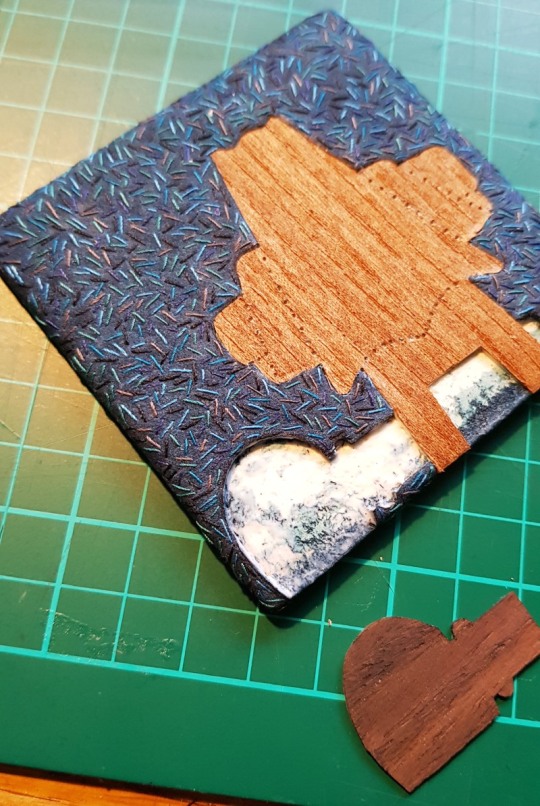
The leather was then pasted to the board, turned in and left to dry. I then cut out the outline of the cello scroll (within the line of stitches) and peeled this away to leave a void. I used two varieties of veneer (Rosewood and Elm), which I backed onto card to give extra thickness and strength, cutting them out very carefully with a sharp scalpel so that they exactly matched the void that they needed to fill.
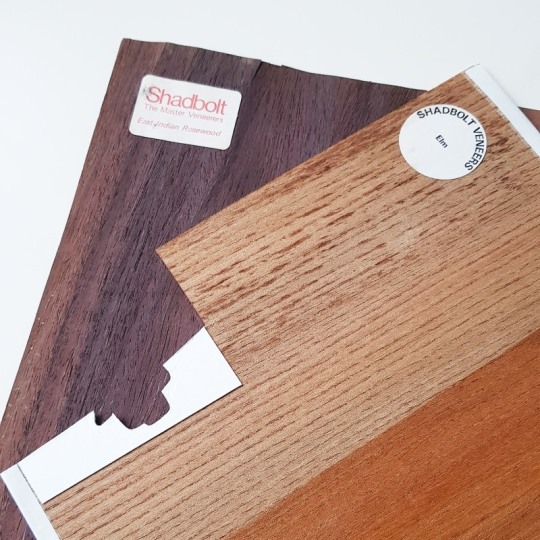
They were glued in place using PVA glue and held with small clips whilst the glue dried to ensure that they dried flat. Where the veneer met the edge of the board I bevelled the veneer to match the profile of the leather as it thinned towards the edges.
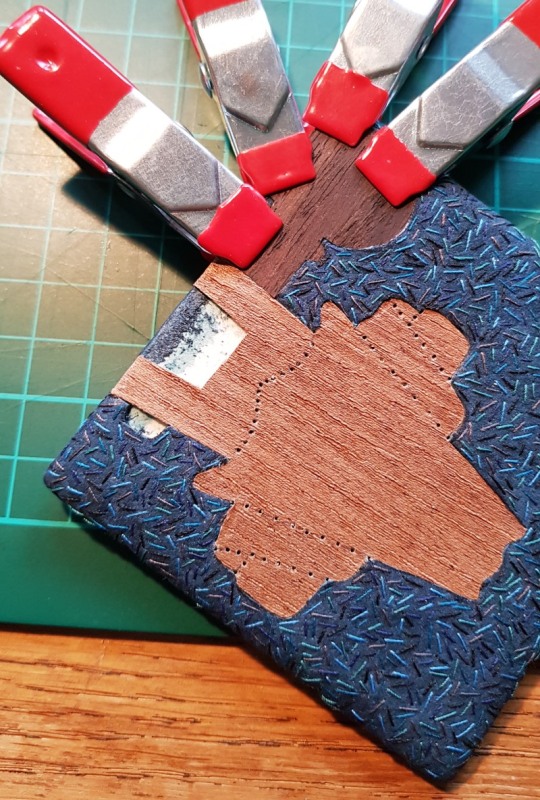
I forgot to take too many photos of how I built up the detail on the veneered sections of the board (I was enjoying this part too much and forgot!), but I drilled small holes right through the board using a fine drill bit in my Dremel and added outlines using thread sewn through these holes. I also added a thin wash of acrylic paint to some areas of the veneer to add an appearance of shading and depth to the surface, plus I also included some detail in gold leaf to jolly up the design!

Finally, I used thin gold wire that was also passed through more small holes drilled in the board to depict the cello string wound round the topmost peg. The wire was passed through the board and embedded into the reverse before being covered with the infill on the back of the board.
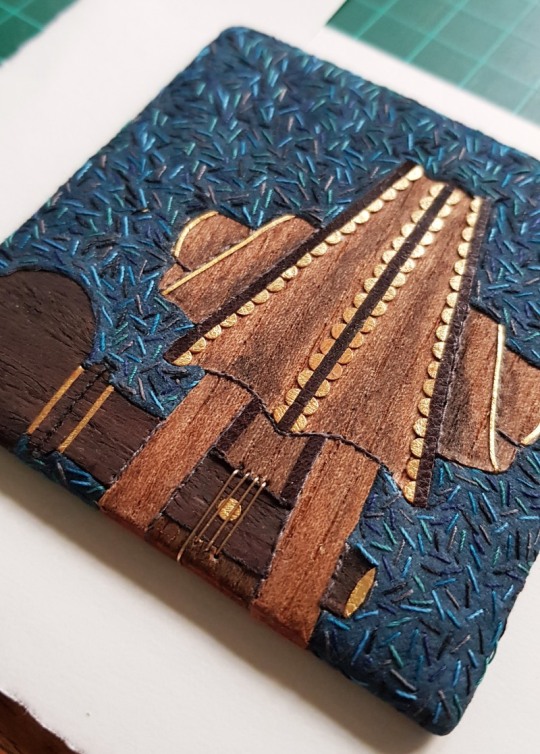
Once the back of the board had been infilled and built up it was time to work on the design for the back of the board. I cut a small piece of vellum to 3 inches square and traced another part of the cello technical drawing onto the reverse of it using a light box. This section included part of the F hole and the bridge that supports the strings.
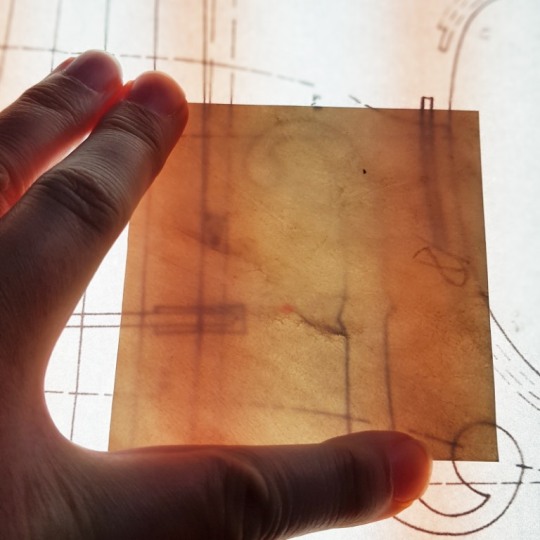
I was then able to use these lines as a guide for embroidering the design using the same colours of thread as used on the front of the board.

I also used some gold leaf and small elements of the “Colvert” bull skin to match what I had used on the front of the board.
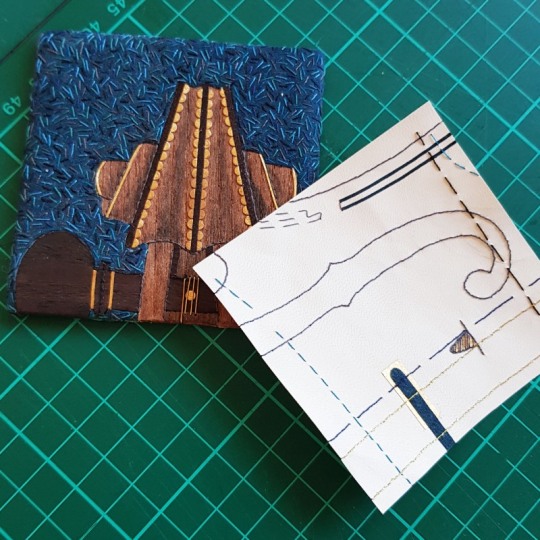
The back of the board was built up with a couple of layers of Zerkall paper and sanded flat. Once the vellum was complete I stuck it down to the back of the board and left it to dry, making sure I rubbed it down all over to ensure it stuck down properly.

And so we had a completed board! All that was left to do was to add my signature and a small number annotation to the vellum back of the board then it was photographed and posted over to join the other boards in New York. This was a very pleasurable little project to work in in amongst other commissions and I was pleased to reminisce back to my more musical days!
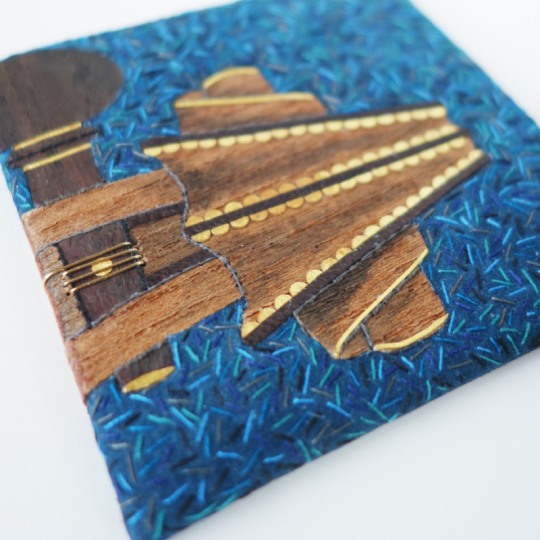
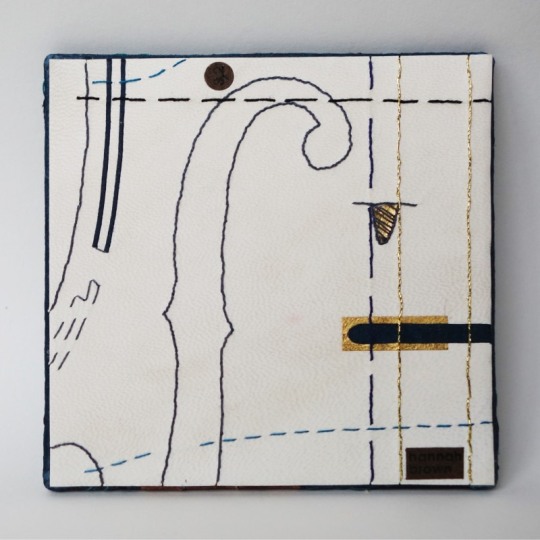
#bookbinding#bookbindingcommission#workofabookbinder#musician#cellist#cellodesign#luthier#leatherbinding#vellumbinding#goldleaf#embroideredbinding#cellomaker#bullskinleather#technicaldrawing#miniatureboard#miniaturebinding#leatherparing#embroiderythreads#celloscroll#cellopegs#cellostrings
15 notes
·
View notes
Text
Project 3 Identity; Research Journals
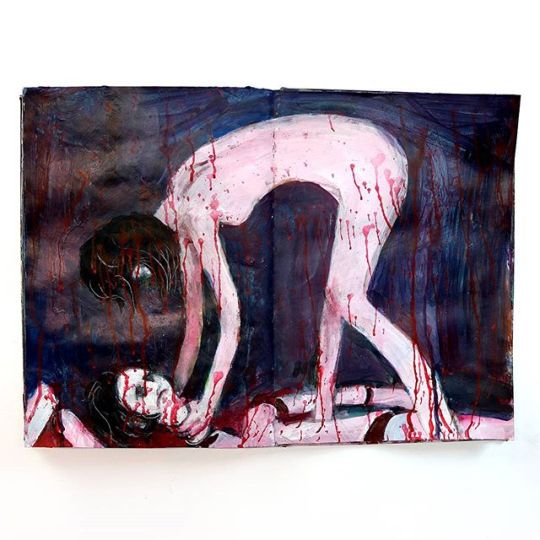
https://www.instagram.com/emornim/
Emor, Torso murder
Form: This piece is a mixed media painting consisting of mostly painting and a little bit of white pencil.
Content: Emor, who is one of my favorite artists, has a very unique way of depicting the various negative emotions that he and many others experience. On his Instagram, he wrote “그래도 자신을 토막낸 자아는 완전하네요” which is a little hard to translate into English, but it essentially says “however, the self (ego/consciousness) that cuts into oneself is perfect”. My understanding of this painting is that it is meant to display how we constantly are overly self-critical of ourselves and are never good enough for ourselves but the perfect self that we are trying to emulate is a version of ourselves that we can never be.
Process: Emor actually films the process of many of his works and uploads them onto youtube. In my opinion, these videos are just as much of an artwork as the final product. For this painting he started out splattered red paint all over a book, then smeared that paint, painted over it in black, painted a figure in yellow, painted over all of that with blue, yellow and red, repainted over all of that with white, dark blue, black and red, and then finally he added details with a white pencil, splattered red paint on it and slammed the book down so the paint would drip down the page.

https://www.huffpost.com/entry/tibetan-art_n_3762140
Dedron , Mona Lisa
Form: This piece is a painting using traditional Tibetan methods of using pigments and dyes on to canvas.
Content: This piece uses traditional Tibetan art visual and creating style mixed with a more western/ late 90’s pop art style to create a new interpretation of the Mona Lisa. This piece takes multiple pieces of the artist's identity and mixes them in a way to show how a rendition of a classic painting would look if it had been done in a style other than its original and with a personal finesse to it.
Process: As stated earlier this piece uses traditional tibentain “painting” methods, wherein mostly straight pigments are used to dye the canvas.
Dedron , Mona Lisa, 2012, Mineral pigment on canvas, The Shelley and Donald Rubin Private Collection
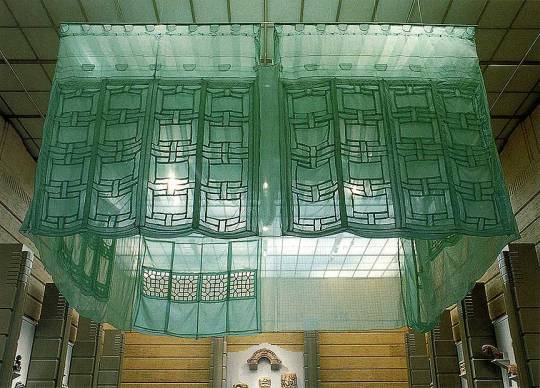
https://art21.org/read/do-ho-suh-seoul-home-la-home-korea-and-displacement/
Seoul home, Do ho Suh
Form: This is an installation piece that is made from fabric that was intricately sewn and designed to look like Do Ho Suh's family home.
Content: This piece was made to bring a piece of his home/ childhood he had in South Korea and bring it to life. This piece also was made with the thoughts of “what is home?” and “Where is home?” in kind. Do Ho Suh talks about as we grow up the meaning of home changes and it becomes very complicated and confusing.
Process: This idea was quite a complicated installation piece to create. Do Ho Suh used a lot of complex and exact details in this piece in order to replicate his family home. In addition to that, he also went to great lengths to get the right fabric. Do Ho Suh commented on his struggles to get the fabric; staying once in an interview: “ My mom helped me to find the right fabric. She introduced me to many different fabric manufacturers. So, for that piece, the fabric was custom-made. I couldn’t find the right color, so we produced for that specific color. And also, she knows a lot of seamstresses, old ladies—“national treasures.”
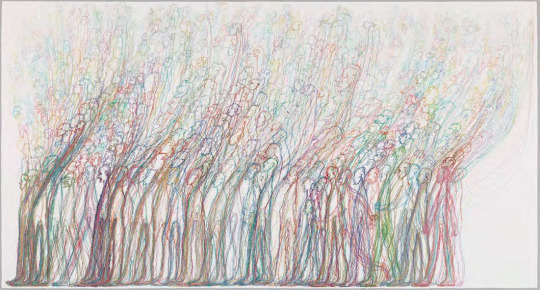
Do ho Suh, Myselves, 2015
https://www.lehmannmaupin.com/artists/do-ho-suh
Form: Thread embedded in cotton.
Content: I couldn’t find much information on this art piece but what I did find is that it is part of a series of similar pieces that use the same technique and style but use different colors and slightly different forms. My interpretation of this piece and the series as a whole is that the colors and different forms represent a part of Do Ho’s personality that makes up the whole that is himself. I see it as similar to how we all have different “Social selves” depending on who we are socializing with.
Process: Because I couldn't find much information on this art piece I don’t know what Do Ho’s process was exactly. All I know about the process of this piece is that it is made from embedding thread into cotton.
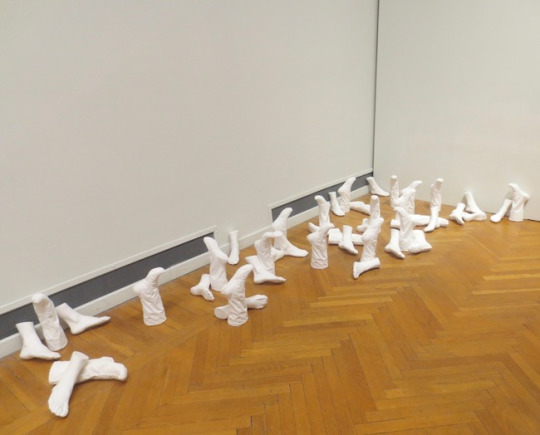
https://mirkaart.com/exploringtheheartofit/2017/9/20/expressing-identity-through-art
Kay Kang, My Journey (Bahljhachwee)
Form: This piece consists of around 40 feet cast in plaster. Some of the feet are bare while others are covered in a traditional sock which Kang constructed from old linens (Ramie) that her family had used.
Content: This piece takes parts of Kays identity which is embedded in her Korean heritage and parts of other parts of her and her identity and combines them. Her Korean heritage is represented by the feet with the socks while the others are meant to be interpreted as steps into the future. The piece shows how the past has made way for her future and how it is a huge part of her identity.
Process: Kay had to first create the socks using old linens and then after that, she made plaster molds of feet wearing socks and some not wearing the socks. After that, she meticulously laid them out for display.
0 notes

